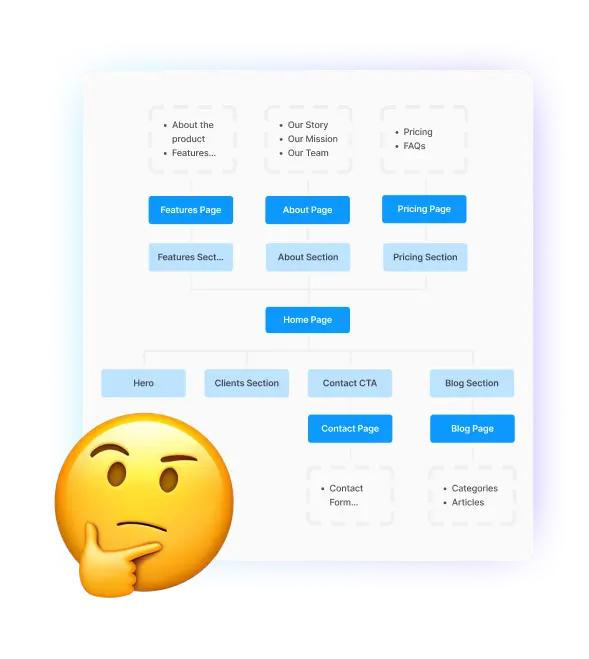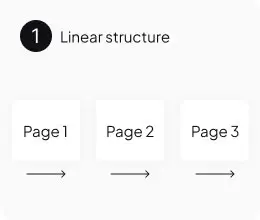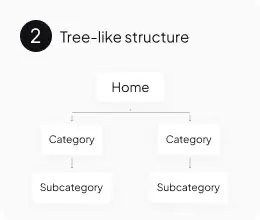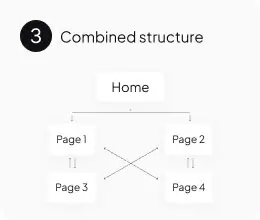Analyzing the structure of the site
Probably, each of us at least once got on sites where to try to find the necessary information is like looking for a needle in a haystack. The only way out of this situation is to carefully consider the structure of the resource at the design stage. We will talk about this today below.



What is a website structure?
A website structure is a hierarchical and logical organization of all its pages, sections, and subsections. You can even say that it is a kind of skeleton of the site on which all the content rests. By dividing the information on the resource into logical blocks, categories, or headings, users will find it easier to navigate the pages and perceive the existing content more easily.
The site structure consists of several key components, each of which plays an important role in the overall organization of the resource.
The first thing we see when we go to a website is the home page. It should clearly reflect the topic – the starting point from which the user begins to get acquainted with the site and further navigate it.
Next, we move on to thematic groups of pages that are organized into logical blocks. These are called sections, which can contain several subsections for more detailed organization of information. It is important that the names of the sections are relevant to the content on the page so that there is no confusion in understanding the information provided.
One of the most important components on pages is navigation elements. These can be menus, links, breadcrumbs, and footers that allow users to navigate between pages and sections. Navigation should be logical, visible, and easy to use.
A harmonious combination of these components forms an effective website structure that is user-friendly and optimized for search engine promotion.


Main types of website structures
There are several main types of website structures, each of which has its own advantages and peculiarities:
Linear structure
- This is the simplest organization when all pages or information are arranged sequentially one after the other, and navigation is carried out in a straight line.
- It is suitable for small websites with a clearly defined order of viewing content, such as landing pages.

Tree structure
- This is the most common type of organization when pages are grouped according to a hierarchical principle – from general to specific. The home page branches into sections, which branches into subsections, and so on.
- This structure is best suited for medium and large websites with diverse content.

Combined structure
- In practice, elements of different types of structures are often combined to achieve the best possible result.
- For example, a tree-like organization of sections with cross-references between thematically related pages.

There are also alphabetical, geographical, and chronological site structures, but they are mostly used in rare and special cases.


The importance of the right structure for users and SEO
The right website architecture is important not only for a good user experience. An unstructured website is a real nightmare for search engines, because they simply cannot understand its content and purpose.
The importance of proper website organization for users
First of all, visitors can quickly navigate the site and find the information they need thanks to the logical distribution of content by topic. By gaining a positive experience of interacting with the website, users become potential customers of your business.
Secondly, intuitive website navigation keeps users’ attention on the resource and imperceptibly inclines them to take certain actions. The easier it is to move from one page to another, the lower the bounce rate.
Thirdly, competent linking between thematically related pages allows you to provide additional relevant information according to the needs of users, which shows their importance as a valuable customer for your business.
Thus, a well-thought-out structure directly affects the behavioral factors of visitors, and thus the conversion rate and business profits in general.
Logical website structure as one of the key factors of its successful promotion in search engines
Firstly, the logical and hierarchical organization of sections and pages allows search engine crawlers to scan and index content more efficiently. This increases the chances of getting your website to the top of the search results for relevant queries.
Secondly, the search engine algorithm ranks and indexes the content of pages that are thematically grouped and relevant to the keywords of the target audience better. Also, a clear structure minimizes the risk of duplicate pages and cannibalization of key phrases, which negatively affect SEO.
Thirdly, the logical architecture of the site helps to create the correct linking between pages and transfer weight and authority to others. Thanks to this, new sections get into the index faster and receive organic traffic.
Fourthly, longer session duration, lower bounce rate, and more page views by users are all positive behavioral factors that affect organic promotion.
Therefore, the development of a well-thought-out website architecture at the design stage lays a solid foundation for further effective promotion.

Increase visibility
for your business: SEO solution for growth!


Basic principles of website structure formation
The process of designing a website is quite a difficult and time-consuming one, because the quality and logic of your future website structure will determine the level of trust from users.
First of all, to create an effective website structure, you need to conduct a thorough analysis of competitors in your niche. This will allow you to see how their resources are organized, what sections and subsections they use, and how they distribute content. After all, your goal is to create a website that is as user-friendly and useful as possible for your target audience.
The next important step in building an effective website structure is an in-depth analysis of the target audience. After all, it is based on the needs, requests, and expectations of your potential users that you collect the semantic core – a list of keywords and LSI phrases that customers most often use to search in your niche.
The next step is to carefully develop a system of categories and subcategories. After all, they are the basis for the logical organization of content. Based on the previous analyzes, you select and group content into thematic and equally important sections. Then you define subcategories, which in turn detail and clarify the content of the section, but do not duplicate each other.
Once you have identified the main categories and subsections of the site, it is important to think about the order in which they are presented in the navigation menu. After all, it is the priority sections that visitors pay attention to in the first place.
When placing emphasis, you should take into account the importance of categories for users and business goals, their popularity according to web analytics, as well as the logical and consistent arrangement.


Mistakes to avoid when creating a website

When building a website structure, it’s important to avoid certain mistakes that can negatively affect the user experience and promotion efficiency. Here are the most common ones:
- Too deep nesting with a large number of subsections, preferably no more than 3-4 levels. This makes navigation difficult and worsens the user experience.
- Uninformative section and page titles that do not reflect their content.
- Lack of interconnection between pages, which makes it difficult to move from one topic to another and makes navigation chaotic.
- Too wide sections with too many pages. If there’re too many, divide them into several narrower subsections by topic.
- URLs don’t match their content and place in the site structure. This worsens the perception of both users and search engines.
Avoiding these mistakes will allow you to create the most effective and understandable website structure that will work for the result.

Increase visibility
for your business: SEO solution for growth!


If you need help
If you need help building and shaping the right website structure for logical and easy navigation, you can contact us. Our experts will help you create a website that will be easily perceived by both potential customers and search engines.
You may also like it

What is usability testing and which type is better to choose
Usability testing is a methodology used to evaluate the usability of a website and improve the user experience. This is the process of systematically..

Typical mistakes of SEO promotion and ways to correct them
SEO mistakes can negatively affect the success of the site and the conversion rate. It is necessary to familiarize yourself with the most common errors

How to use visual content marketing to attract an audience?
Imagine the situation: you've created a website, filled it with informative and interesting text, but the strategy of attracting consumers with text alone no longer...









